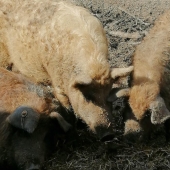

 1
1




What is a Mangalitsa Pig?
In 2006, Heath Putnam, the founder of Heath Putnam Farms, encountered Mangalitsa while working in Europe. Impressed by its exceptional quality, and aware that America had nothing comparable, he imported a herd and began production here in Washington State. Unlike all popular breeds of hogs, which are meat-type, the Mangalitsa is an extreme lard-type breed. The Mangalitsa (pronounced MON-go-leet-sa) was created in 1833 by the Hungarian Royal Archduke Jozsef. Lard-type breeds produce high-quality fat and very marbled, juicy and flavorful meat. Mangalitsa fat is more unsaturated than normal pig fat, so it tastes much lighter, cleaner and melts at a lower temperature. The fat is also healthier and keeps longer, due to higher levels of oleic acid. For more information on Mangalitsa pork and where to find it, visit Heath Putnam Farms.

QuickBooks set up and Bookkeeping for Small Businesses and Farms - jocelyncampbell.com




The ultimate goal of farming is not the growing of crops, but the cultivation and perfection of human beings. - Masanobu Fukuoka










hubert cumberdale wrote:
wheres the recipe for making the pancetta?


QuickBooks set up and Bookkeeping for Small Businesses and Farms - jocelyncampbell.com





The ultimate goal of farming is not the growing of crops, but the cultivation and perfection of human beings. - Masanobu Fukuoka













"When there is no life in the soil it is just dirt."
"MagicDave"






















Pigs get fatter hogs get slaughtered? semantics. I have slaughtered my pigs and eaten them too.John Polk wrote:
I am also considering Large Blacks. As the name suggests, they will produce a large hog.
If you pasture them, they will provide a lean hog. On grain feed, a lot of lard.
(For those that don't understand the difference between "pigs" and "hogs", it's simple:
Pigs get fatter. Hogs get slaughtered!)
"When there is no life in the soil it is just dirt."
"MagicDave"




www.thehappypermaculturalist.wordpress.com
 2
2




 )
)












Those who hammer their swords into plows will plow for those who don't!








 1
1




Brian McNabney wrote:Any other good grass eaters ?









 1
1




 4
4




Community Building 2.0: ask me about drL, the rotational-mob-grazing format for human interactions.

|
Would you turn that thing down? I'm controlling a mind here! Look ... look at the tiny ad ...
Play Your Way to a Sustainable Lifestyle: Uncover Permaculture Principles with Each Card
https://gardener-gift.com/
|






